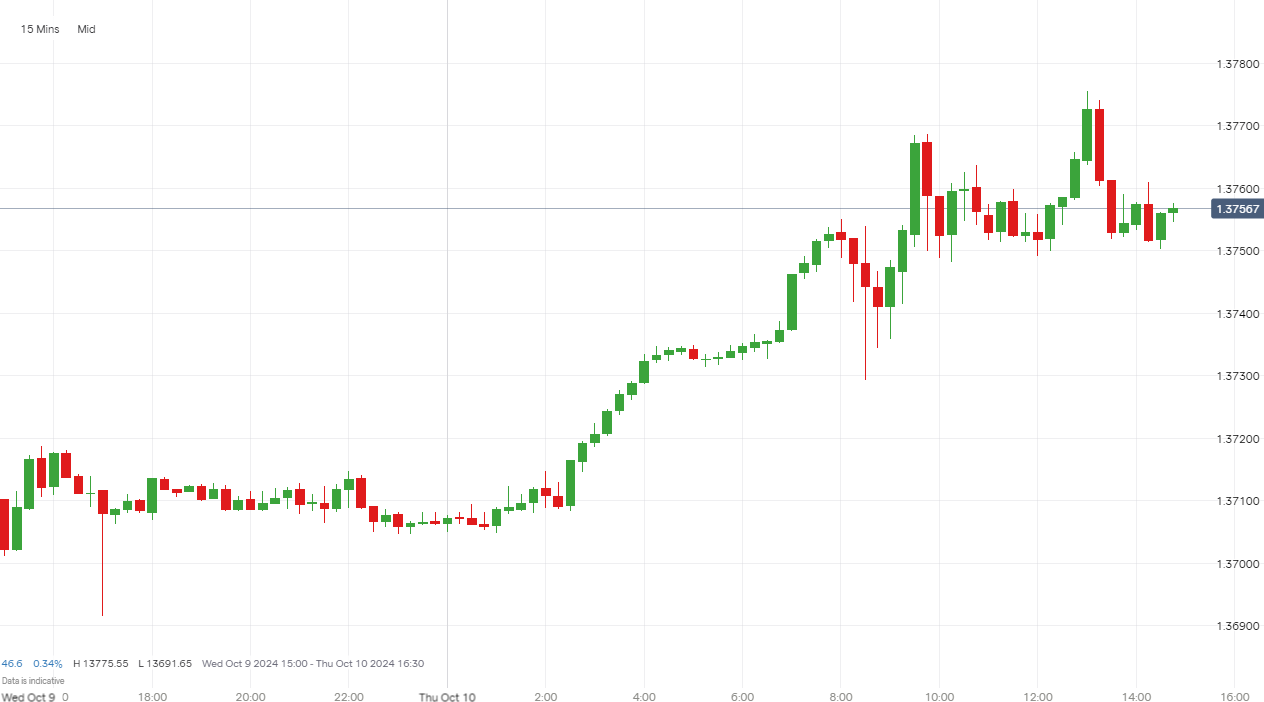USD/CAD pair moving through highs
Explore how Canada's trade deficit and oil export decline affect CAD, while US dollar gains strength amid Fed rate expectations—key insights for navigating USD/CAD forex strategies await.

Key Points
- USD/CAD trades at 1.37756, CAD underperforms
- Canada's trade deficit widens to CAD 1.10 billion
- 4.1% decline in Canadian crude oil exports
- US dollar index surpasses 102.9, monthly high
- 11.6% probability of no Fed rate cuts in November
USD/CAD Trades Above 1.377
Today’s trading session has highlighted the Canadian dollar (CAD) as an underperformer, weakening past the critical 1.37 level against the US dollar to 1.37756. This shift can be attributed to several factors, including fluctuations in global oil prices—significant for Canada as a major oil exporter. Moreover, economic indicators such as widening trade deficits or weaker-than-expected Canadian data exert additional pressure on the CAD. Concurrently, the sustained strength of the US dollar, driven by factors like higher interest rates and a robust US economic performance, compounds challenges for the loonie, making it less appealing to forex investors.
USD/CAD price history

Poor Export Data Contributes to the CAD’s Bearish Trend
Canada's trade deficit widened significantly to CAD 1.10 billion in August 2024, marking the largest gap since May and exceeding forecasts and July’s deficit of CAD 0.29 billion. This growing deficit pressures the CAD, reflecting higher imports relative to exports. A 4.1% decline in crude oil shipments, Canada's top export, likely plays a major role in the CAD's downward trend. Analysts anticipate weakened labor market data this Friday, which could lead to further monetary easing by the Bank of Canada. Such easing might impact the CAD’s value, affecting forex trading strategies focused on this currency pair.
US Dollar Maintains Bullish Run Amid Rate Cut Recalibration
Despite a volatile start following inflation data releases, the US dollar has maintained its bullish trend, with the dollar index surpassing 102.9, reaching a monthly high. With a rising probability of the Federal Reserve not implementing rate cuts in November—currently at 11.6%—the USD could strengthen further, attracting foreign investment due to competitive returns. If the Fed maintains or raises interest rates, this could enhance the dollar's strength. However, significant rate cuts could weaken the dollar as investors seek alternatives. These potential scenarios are critical for traders assessing forex market movements.
What’s Next for USD/CAD?
Canada’s trade deficit, driven by a 4.1% decline in crude oil shipments, highlights vulnerabilities in its trade balance, exerting pressure on the CAD. Weaker labor market data expected this Friday may prompt further monetary easing by the Bank of Canada, potentially affecting the CAD’s performance. Conversely, the US dollar's bullish trend is supported by recalibrated expectations of Fed rate cuts. With the dollar index exceeding 102.9 and increasing odds of the Fed holding off on rate cuts, the USD could attract foreign investment. If these trends persist, USD/CAD may rise further. Traders should closely monitor economic data and central bank decisions to navigate potential volatility.
How to trade USD/CAD
- Open an account to get started, or practice on a demo account
- Choose your forex trading platform
- Open, monitor, and close positions on USD/CAD
Trading forex requires an account with a forex provider like tastyfx. Many traders also watch major forex pairs like EUR/USD and USD/JPY for potential opportunities based on economic events such as inflation releases or interest rate decisions. Economic events can produce more volatility for forex pairs, which can mean greater potential profits and losses as risks can increase at these times.
You can help develop your forex trading strategies using resources like tastyfx’s YouTube channel. Our curated playlists can help you stay up to date on current markets and understand key terms. Once your strategy is developed, you can follow the above steps to open an account and get started trading forex.
Your profit or loss is calculated according to your full position size. Leverage will magnify both your profits and losses. It’s important to manage your risks carefully as losses can exceed your deposit. Ensure you understand the risks and benefits associated with trading leveraged products before you start trading with them. Trade using money you’re comfortable losing. Past performance is not indicative of future results.
